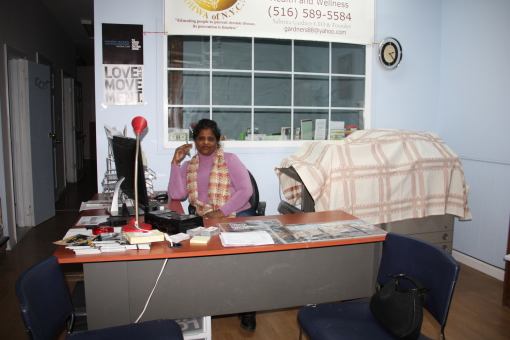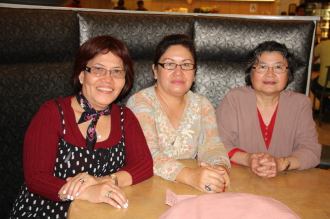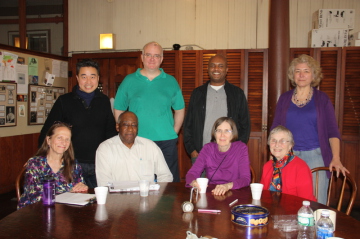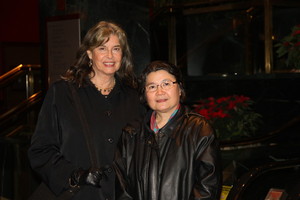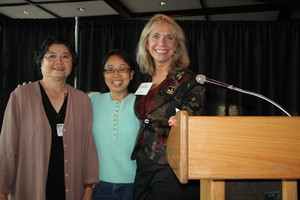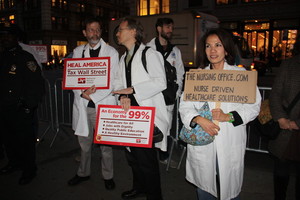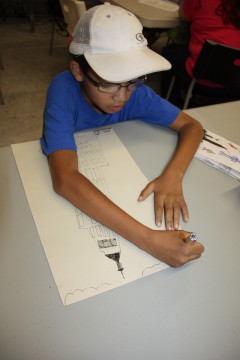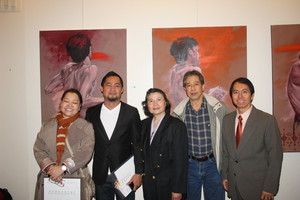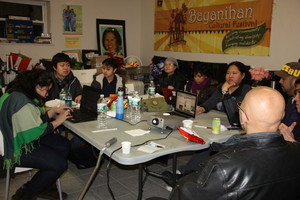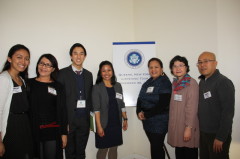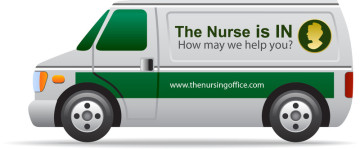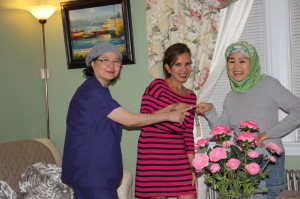The Nurse is IN: “How may we help you?”
As nurses are given the challenge to lead individuals, families and communities toward health maintenance and promotion, we show our willingness to accept this responsibility by making ourselves available at your service.
The Nurse is IN program will make you feel the nurses’ presence and genuine interest in your health through socio-cultural and economic approaches to your well-being. It is our sincerest way to deliver our message of caring for communities, delivering public healthcare for all, resolving health disparities and promoting equality and equity for people of color and challenging the healthcare apartheid. It is a sign of our presence in the community. How may we help you?
The Nurse is IN is one of our Nurse Driven Healthcare Solutions as a community and public health delivery system to ensure healthcare for all and ensure the first level of defense against diseases and illnesses and reduce healthcare cost while ensuring quality healthcare and equity for all. Our goals are consistent with the goals of Healthy People 2020., TCNY.
The Nurse is IN is our initiative in respond to the:
The RWJF Initiative on the Future of Nursing at IOM
The Future of Nursing
Leading Change, Advancing
Health
OCTOBER 2010
With more than 3.6 million members, the nursing profession is the largest segment of the nation’s
health care workforce. Working on the front lines of patient care, nurses can play a vital role in helping to realize the objectives set forth in the 2010 Affordable Care Act, legislation that represents the broadest health care overhaul since the 1965 creation of the Medicare and Medicaid
programs. A number of barriers prevent nurses from being able to respond effectively to rapidly changing health care settings and an evolving health care system. These barriers need to be
overcome to ensure that nurses are well-positioned to lead change and advance health.
In 2008, The Robert Wood Johnson Foundation (RWJF) and the Institute of Medicine (IOM) launched a two-year initiative to respond to the need to assess and transform the nursing profession. The IOM appointed the Com¬mittee on the RWJF Initiative on the Future of Nursing, at the IOM, with the purpose of producing a report that would make recommendations for an action-oriented blueprint for the future of nursing.
Nurses practice in many settings, including hospitals, schools, homes, retail health clinics, long-term care facilities, battlefields community and public health centers. They have varying levels of education and competencies—from licensed practical nurses, who greatly contribute to direct patient care in nursing homes, to nurse scientists, who research and evaluate more effective ways of caring for patients and promoting health. The committee considered nurses across roles, settings, and education levels in its effort to envision the future of the profession. Through its deliberations, the committee developed four key messages that structure the recommendations presented in this report:
A number of barriers prevent nurses from being able to respond effectively to rapidly changing health care settings and an evolving health care system. These barriers need to be overcome to ensure that nurses are well-positioned to lead change and advance health.
1)
Nurses should practice to the full extent of their education and training in accordance wit.h the Nurse Practice Act. While
most nurses are registered nurses (RNs), more than a quarter million nurses are advanced practice registered nurses (APRNs), who have masters or doctoral degrees and pass national certification
exams. Nurse practitioners, clinical nurse specialists, nurse anesthetists, and nurse midwives all are licensed as APRNs.
Because licensing and practice rules vary across states, the regulations regarding scope-of-practice—which defines the activities that a quali¬fied nurse may perform—have varying effects on different
types of nurses in different parts of the country. For example, while some states have regulations that allow nurse practitioners to see patients and prescribe medications without a physician’s
supervision, a majority of states do not. Consequently, the tasks nurse practitioners are allowed to perform are determined not by their education and training but by the unique state laws
under which they work.
The report offers recommendations for a variety of stakeholders—from state legislators to the Centers for Medicare & Medicaid Services to the Congress—to ensure that nurses can practice to the
full extent of their education and training. The federal government is particularly well suited to promote reform of states’ scope-of-practice laws by sharing and providing incen¬tives for the
adoption of best practices. One sub-recommendation is directed to the Federal Trade Commission, which has long targeted anti-competitive conduct in the health care market, including
restrictions on the business practices of health care providers, as well as policies that could act as a barrier to entry for new competitors in the market.
High turnover rates among new nurses underscore the importance of transition-to-practice residency programs, which help manage the transition from nursing school to practice and help new graduates further develop the skills needed to deliver safe, quality care. While nurse residency programs sometimes are supported in hospitals and large health systems, they focus primarily on acute care. However, residency programs need to be developed and evaluated in community settings.
2) Nurses should achieve higher levels of education and training through an improved education system that promotes seamless academic progression.To ensure the delivery of safe, patient-centered care across settings, the nursing education system must be improved. Patient needs have become more complicated, and nurses need to attain requisite competencies to deliver high-quality care. These competencies include leadership, health policy, system improvement, research and evidence-based practice, and teamwork and col-laboration, as well as competency in specific content areas including community and public health and geriatrics. Nurses also are being called upon to fill expanding roles and to master technological tools and information management systems while collaborating and coordinating care across teams of health professionals.
Nurses must
achieve higher levels of education and training to respond to these increasing demands. Education should include opportunities for seamless transition into higher degree programs—from licensed
practical nurse (LPN)/licensed vocational nurse (LVN) diplomas; to the associate’s (ADN) and bachelor’s (BSN) degrees; to master’s, PhD, and doctor of nursing practice (DNP) degrees. Nurses
also should be educated with physicians and other health professionals both as students and throughout their careers in lifelong learning opportunities. And to improve the quality of patient
care, a greater emphasis must be placed on making the nursing workforce more diverse, particularly in the areas of gender and race/ethnicity.
3)Nurses should be full partners, with physicians and other health care professionals, in
redesigning health care in the United States.
Efforts to cultivate and promote leaders within the nursing profession—from the front lines of care to the boardroom—will prepare
nurses with the skills needed to help improve health care and advance their profession. As leaders, nurses must act as full partners in redesign efforts, be accountable for their own
contributions to delivering high-quality care, and work collaboratively with leaders from other health professions.
Being a full partner involves taking responsibility for identifying problems and areas of system waste, devising and implementing improvement plans, tracking improvement over time, and mak-ing
necessary adjustments to realize established goals. In the health policy arena, nurses should participate in, and sometimes lead, decision making and be engaged in health care reform-related
implementation efforts. Nurses also should serve actively on advisory boards on which policy decisions are made to advance health systems and improve patient care.
In order to ensure that nurses are ready to assume leadership roles, nursing education pro¬grams need to embed leadership-related compe¬tencies throughout. In addition, leadership devel¬opment
and mentoring programs need to be made available for nurses at all levels, and a culture that promotes and values leadership needs to be fostered. All nurses must take responsibility for their
personal and professional growth by developing leadership competencies and exercising these competencies across all care settings.
4)
Effective workforce planning and policy making require better data collection and an improved information infrastructure.
Planning for fundamental, wide-ranging changes in the education and deployment of the nursing workforce will require comprehensive
data on the numbers and types of health professionals—including nurses—currently available and required to meet future needs. Once an improved infrastructure for collecting and analyzing
workforce data is in place, systematic assessment, and projection of workforce requirements by role, skill mix, region, and demographics will be needed to inform changes in nursing practice and
education.
The 2010 Affordable Care Act mandates the creation of both a National Health Care Workforce Commission to help gauge the
demand for health care workers and a National Center for Workforce Analysis to support workforce data collection and analysis. These programs should place a priority on systematic monitoring of
the supply of health care workers across professions, review of the data and methods needed to develop.
To ensure the delivery of safe, patient-centered care across settings, the nursing education system must be improved. Patient needs have become more complicated, and nurses need to attain
requisite competencies to deliver high-quality care.
Conclusion
The United States has the opportunity to transform its health care system, and nurses can and should play a fundamental role in
this transformation. However, the power to improve the current regulatory, business, and organizational conditions does not rest solely with nurses; government, businesses, health care
organizations, professional associations, and the insurance industry all must play a role.
The recommendations presented in this report are directed to individual policy makers; national, state, and local government leaders; payers; and health care researchers, executives, and professionals—including nurses and others—as well as to larger groups such as licensing bodies, educational institutions, philanthropic organizations, and consumer advocacy organizations. Working together, these many diverse parties can help ensure that the health care system provides seamless, affordable, quality care that is accessible to all and leads to improved health.
A Model for an Integrative and Participative Concept of Community and Public Health Care Delivery
VISION
A community centre where learning, health, and wellness is developed through integrating existing health care concepts and practices (traditional, alternative, and complementary), and developing the informed participation of individuals, their families, and communities in its implementation and applications.
MISSION
To develop health-empowered individuals skilled in health maintenance; trained and supported in sustaining their own well-being, in order to serve families, groups, and the general community.
Philosophy and General Assumptions
Utilizing existing information from the Federal, State, and City health departments including (but not limited to), mortality & morbidity rates; Census demographics on literacy & educational levels; primary & secondary languages spoken; immigration status; and other socio-economic indicators, the model seeks to engage the participative energies of members of the focused community in addressing the unmet health care needs and access issues of their families, groups, and other social networks.
This model seeks, as a consequence, to eventually wean groups and populations dependent on Medicare & Medicaid and other such programs; relieve such persons of the burden of over-medication and chronic lack of adequate and suitable health care; reduce overall individual health care costs by reducing dependency on government health agencies and/or health care facilities; and increase individuals’ economic participation and productivity.
It is hoped that this model could be replicated anywhere in the USA as well as in any part of the world, to address the urgent health care needs of the uninsured, underserved, high-risk, and, even almost, invisible sectors of our societies as well as the international community on global health.
UNITED STATES: DESIGNING AFFORDABLE HEALTHCARE
Proposed Activities for Community Center
Social:
“Dream America” Project
This will integrate programs to address social and political issues as Citizenship, Immigration, Rights, Duties and Responsibilities of US citizenship.
- Immigration Counseling and referral
- Immigration Workshops
- Education on Election process, rights and responsibilities
- Housing and Prevention of Homelessness
- Legal Assistance
- Racial Discrimination and Bullying
Cultural:
- Promotion of arts, culture and ethnicity
Economic:
- Job Training and Placement
- Creation of Jobs & Entrepreneurship
- Financial Literacy
Education:
- English as second language (ESL)
- Graduate Equivalency Program (GED)
- Adult Basic and Continuing Education
Healthcare Delivery (Community and Public Health)
Include programs on:
- Advocacy, Prevention, Screening and Referral
- Access to Health Services
- Training of Community Healthcare Workers
Family:
- Family Counseling
- Domestic Violence Prevention
- Drug/Alcohol Abuse Prevention
Maternal:
- Birth Control and Responsible Parenthood
- Infant Health and Breast Feeding
Child and Adolescents Health
- Early Childhood Development
- Youth Services and Development
- Teenage Depression and Prevention of Suicide
- Diabetes
- Teenage Pregnancy
- Smoking
- Obesity
Men’s Health:
- Alcoholism
- Smoking Cessation
- Cardiovascular Health
- Diabetes
Women’ Health:
- Family Planning
Lesbian, Gay, Bisexual and Transgender(LGBT) Health:
- HIV/AIDS
- Sexually Transmitted Diseases
Senior Citizens:
“How to celebrate your 100th birthday?”
This program will include issues affecting the care of the aging population
- Care of the Elderly
- Adult Day Care Centers
- Disposition and Placement
- End of Life/ Quality of Life Education
Public Health Initiatives: Healthy People 2020
- Emergency Preparedness and Management/Recovery Programs
- Occupational Safety and Health
- Oral Health
- Mental Health
- Vision Disorders
- Sleep Disorders
- Respiratory Diseases
Chronic Diseases
- Cardiovascular Diseases/ Heart Disease and Stroke
- Diabetes
- Hypertension
- Obesity
- TB
- Hepatitis
Miscellaneous Services and Programs
- Veteran Services
- Healthcare System and Delivery
- Environmental Health/ Greening of the Environment
- Basic Life Support Training
Lutgarda M. Resurreccion
Director of Programs & Development
Myrna D. Santos, MSN, RN
Chief Nurse Executive & Founder
The Nursing Office
PHILIPPINES: A PARTNERSHIP OF NURSES and COMMUNITIES
Championing Nurses and People
While the Philippines has been a “Nurse Nation” providing nurses to the international community since the 1960’s, it is also noted as one of the great examples of a successful “People Power” as it mobilized the people to overthrow a government oppressing the people. There is no doubt that this country that has surplus of nurses should not be able to take care of its people given a well designed model of delivery and infrastructure.
We are calling all nurses to establish and organize their own nursing office in their communities. This program will ensure jobs for thousands of nurses and continued interactive preventative healthcare for communities as we empower them to have initiatives and leadership, as well as empower the people to take care of themselves.
As the Philippine population grows enormously, how can these people be taken cared of en masse effectively? While there is an abundance of unemployed nurses, we are taking the initiative to design a model where we can put nurses to work .Therefore, we are calling all nurses to respond and accept this challenge to take care of our people and communities.
Phases of Development
Phase I
· Identify registered nurses, retired nurses, student nurses and related healthcare providers.
· Identify community resources: governmental, non-governmental organizations (ngo), personal/individual.
· Leadership Training: Empower the Nurse
Phase II
· Identify targeted communities
· Community assessment of needs
· Community Organizing: Empower the People
Phase III
· Designing programs and services based on the needs
· Design Program Plan and Sustainability
Phase IV
· Implementation of Programs
· Sustainability and Funding
Phase V
· Documentation: photos and written summary of report
· Assessment of Effectiveness of programs and services
The Nursing Office-Philippines
The Nursing Office Phillipines is now an active organization, led by Dr. Leticia Puguon, PhD, RN, to promote the mission and vision of Community and Public Health Delivery, as a Nurse Driven Healthcare Solution. The organization involve nurse volunteers and other civic-oriented individuals in the region of Nueva Vizcaya.
ACTIVITY REPORT
Leticia Puguon, PHD, RN
Hello Maam Myrna & Ludy....am still doing social mobilization by recruiting volunteer nurses to join me in this endeavor while integrating in communities I find to be in need of assistance in community development...this project of TNO is so challenging and though still toxic in my activities, I have to persevere so that this project would really go down the grassroots...Will be presiding our General Assembly of our NVPEA 19th Anniversary tomorrow in the Capitol and the preparations had really been taxing and the evaluation of those efforts will be measured after the program would be over...this is really a test of leadership..
Leticia Puguon, PhD, RN
September 8, 2013
Had my 1st Community Outreach today at Barangay Bansing, Bayombong,Nueva Vizcaya(10 kms from the Poblacion) where I gave out micronutrient supplements (iron syrup, micronutrient powder and deworming tablets to ten(10) pre-schooland school children who attended church service in the Outreach Church of Bayombong United Methodist Church because I was invited Speaker in their Harvest Festival Sunday...I also did a therapeutic massage to a senior citizen with body aches...This is the start of our Community Outreach for The Nursing Office's The Nurse Is In Project..I will have my Orientation Meeting with Nurse Volunteers before or after my trip to Bangkok, Thailand on Sept. 18-20, 2013....More activities are planned and to be implemented somehow..please pray for our Project to push through...Lastly, I need sponsors for my airfare to Bangkok...Thanks to those who will positively respond...God bless you..
Leticia Puguon, PhD, RN
September 15, 2013
Good morning from Nueva Vizcaya, Philippines!! I was in Echague, Isabela yesterday PM to attend the Meeting of the PNA, Isabela Chapter Officers..It was my opportunity to share to Nurses Fely Balico, President, Miriam Macutay, VPPD and Tony, COMELEC Chair the Project: The Nurse Is In of The Nursing Office which they all welcomed to implement in the Province of Isabela, Philippines, the biggest province in Cagayan Vallley as to population and land area. This would be an expansion of The Nursing Office-Nueva Vizcaya. I shared to them a copy of the project concept. This, will somehow help in the strengthening the Association's weakening status because there are only few officers attending their meetings..I am appealing for Nurses from Isabela Province based and making good abroad would share some of your resources, cash or in kind for the start of our Project in Isabela as soon as we can.. We need BP apparatus and other simple medical and nursing gadgets we can use in our community outreach and Health Fairs in support to the government in Nation-Building... may this appeal touch your hearts!! I hope Vincent will respond positively on this by inviting your colleagues there to respond to this call...Thank you and God bless you!!
You may follow their activities in this Face Book link:
Church of Scientology (Harlem)
HTS
Northwell Health
Phillipine Community Center Services for Aging (PCCSA)
Rehabworld (NYC)
Santo Nino Museum (NJ)
TCI (Flushing)
Queensburrogh
NYC





